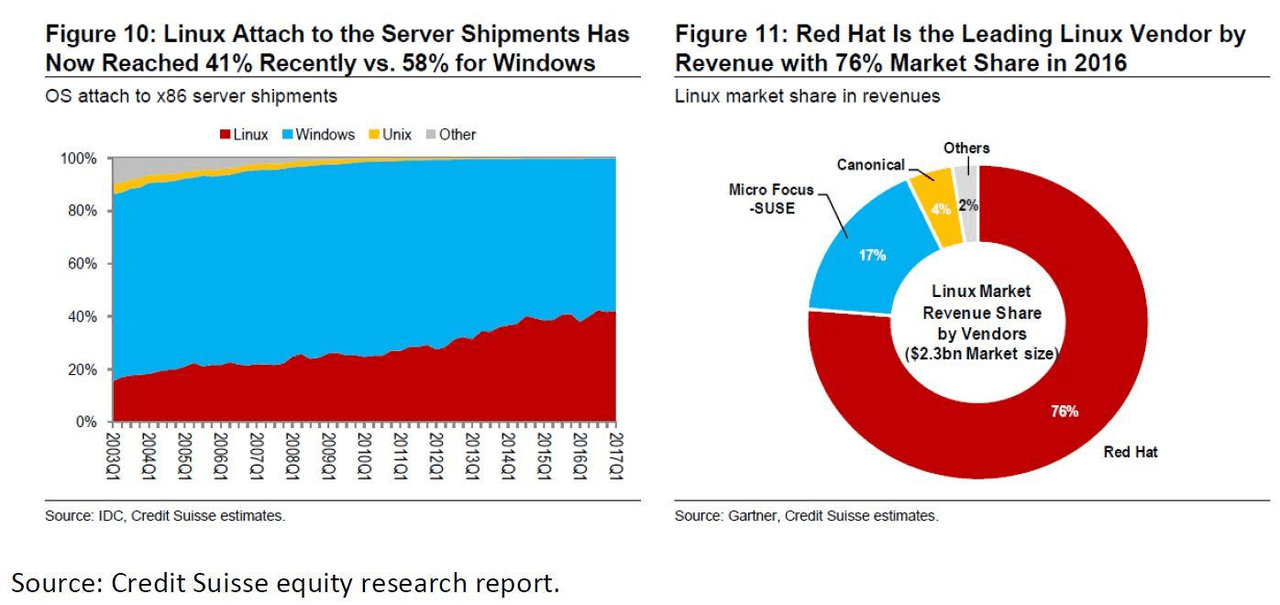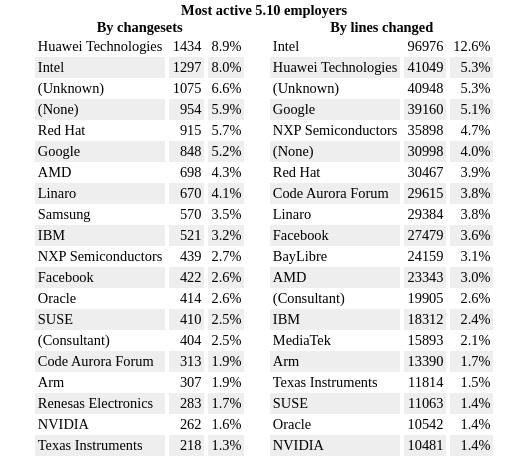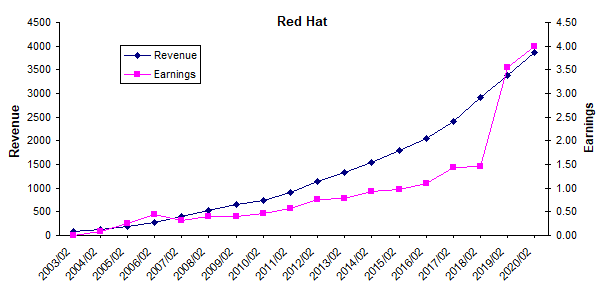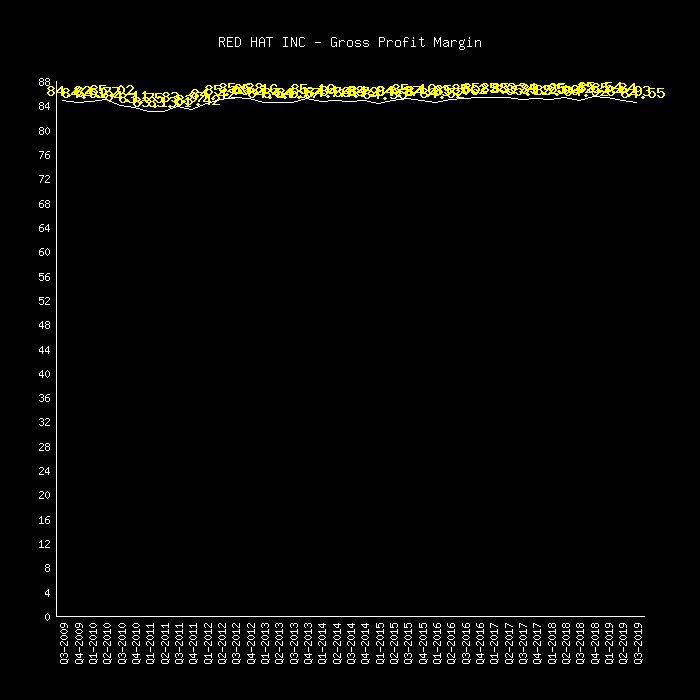Themes: Open-Core And Long-Term Alpha (Pt.1)

Summary
- In this first part of the report, we'll explore the history of open-source, the birth of the open-core model, and the benefits and challenges it presents.
- We'll also discuss the ways in which it has disrupted traditional software development paradigms.
- For the next three parts, we will be diving into specific open-core sectors and individual public companies and startups across data, infra & DevOps, and security.
Related Companies: Elastic (ESTC), MongoDB (MDB), Confluent (CFLT), Hashicorp (HCP), Gitlab (GTLB), Databricks, Snyk, Kong, Red Hat (acquired by IBM), MuleSoft (acquired by CRM), MySQL (acquired by ORCL)
Introduction
Open-core businesses have recently gained traction, demonstrating strong growth and offering considerable long-term alpha potential. With the early success of some open-core businesses, many startups followed suit and some of them have gone public in the past decade. In more recent years, we are seeing an acceleration both in the number of open-core companies filing for IPO, but also an aggressive funding environment for open-core startups. However, the business remains largely misunderstood.
There are periods of the time when these companies post bad results, and investors start to question the foundation of the business. Investors typically argue that open-sourcing your core product's code base is a terrible idea and the company has no moat, and hence no investment value.
There are also periods of the time when these companies surprise investors with expectation beats, and investors start to build up stories, so the ends justify the means. Investors then cherish every aspect of the open-core business model and price the company to perfection.
The truth is always somewhere in between, and we believe that open-core remains a largely misunderstood business model that contains a significant amount of long-term alpha. Here, we dedicate Part 1 to share our perspectives on
- The rationale for open-core
- The moat
- The economics
- The future & investment implications
For the next three parts, we will be diving into specific open-core sectors and individual public companies and startups.
Part 2 - Data
Part 3 - Infrastructure and DevOps
Part 4 - Security
The History of Open-Source Software
The idea of open-core has been very contentious from the beginning for obvious reasons - who will pay you if anyone can download, edit, and tailor your software code to their own needs?
Before we address this, we need to understand the open-source movement itself was, and still is to some extent today, a misunderstood one. For many outsiders, the open-source movement is a utopian effort that is destined for self-destruction.
The Beginnings of Open-Source Software (OSS)
The concept of open-source software dates back to the earliest days of computing when software was often shared and collaboratively developed by researchers and programmers. It was only later, with the rise of proprietary software and licensing, that the idea of keeping source code private became the norm.
In the 1980s, Richard Stallman, a prominent programmer, and advocate for free software, founded the GNU Project and the Free Software Foundation. Stallman believed that software should be free to use, modify, and redistribute, and he sought to create an operating system that embodied these principles. The GNU Project laid the groundwork for what would later become the open-source movement.
In the late 1990s, the term "open source" was coined to create a pragmatic approach which was differentiated to the more ideologically-driven free software movement. The open-source movement focused on the practical benefits of open collaboration and sharing, rather than on the moral and ethical arguments for software freedom.
The open-source movement gained significant momentum with the release of the Linux operating system, which was based on the earlier work of the GNU Project. Developed by Linus Torvalds, Linux rapidly gained a following among developers and eventually became a popular choice for server and embedded systems. The early and long-tailed success of Linux demonstrated the power of open-source development and the potential for collaboration among developers to create high-quality software.

The Birth of the Open-Core Model
Pros and Cons
The common intuition is simple. Open source means a developer or a group of developers, voluntarily sharing the source code of the software, maintaining and updating the code base whenever there is a new bug, feature suggestion, or security vulnerability. The basic rule of market capitalism dictates that this way of collaboration would result in inferior code quality, and overall reliability, and thus not applicable for mass adoption. Furthermore, with source code exposed to the public, the hacker can exploit the vulnerable code and compromise the existing software. At the same time, because developers assume no responsibility for the security and reliability of the code, they won't come to the rescue immediately when the entire house is burning. There is a grain of salt to this argument as a vast majority of open-source projects are not used by many, and are soon deprecated and not maintained by the developer.
On the other hand, for a small amount of open-source projects that have an active user base and active developer maintenance, the flywheel is clear. The nature of open-source means that the software can touch the broadest user base possible. It is not only because the software can be downloaded for free, but also because the source-code is completely open such that you have 100% flexibility to do any modification you want. With the broadest user base possible, the developer can source and ingest the most voluminous feedback possible. As everyone can access the source code, in a benign and active community, users will actively share their suggestions to improve the code quality, propose commits for fixing bugs or adding new functions, and discuss the design with developers to improve the code base together.
Big and active user base = better quality, security, and features for the code base = more users
There is only one thing missing here - the incentive mechanism to keep the developer 100% committed to the success of the project.
The missing turbocharger in the OSS flywheel
Addressing the Limitations of Traditional OSS Models
While the open-source movement had shown the potential for creating high-quality software through collaboration, it faced challenges in terms of financial sustainability and incentives for developers.
Without capitalism and a free market system to create financial support for OSS projects, the developers and maintainers of the OSS project can't deliver the best work. In some special cases like Linux, the project was so foundational that big corporations are more than willing to allow their employees to work full-time on contributing to the free OSS project. These companies are often chip companies or infrastructure companies whose business success hinges on the success of the Linux ecosystem. As such, they are more than willing to fund and support the developer directly through donations.
For a large number of smaller projects, however, a better incentive mechanism is needed, which is open-core. As you may notice in the following table, within top Linux contributors, there are two standalone software companies - Red Hat and SUSE - whose business is built entirely on providing the support services for Linux OS.

Guess Who Contributed the Most to Linux Kernel 5.10 Development? It's Huawei (and Intel)
Red Hat: The Pioneer of the Open-Core Model
Red Hat was one of the first companies to successfully adopt the open-core model, offering a free, robust Linux distribution with professional support services. The company developed Red Hat Enterprise Linux (RHEL), which was free to use but required payment for support services.
Bob Young, a Canadian entrepreneur, played a critical role in the creation of Red Hat. Before co-founding Red Hat, Young started a company called ACC Corporation, which focused on selling Linux and Unix software accessories through a mail-order catalog. This venture allowed Young to gain valuable experience in the emerging Linux market and develop his understanding of the potential business opportunities in the open-source space.
Young's entrepreneurial spirit, combined with his belief in the power of open-source software, made him an ideal partner for Marc Ewing, who had the technical expertise to create a high-quality Linux distribution.
Marc Ewing, an American software engineer, created the original Red Hat Linux distribution while studying at Carnegie Mellon University. Ewing named the distribution after his grandfather's red lacrosse cap, which he wore as a good luck charm during exams. After graduating, Ewing continued to develop and improve Red Hat Linux, attracting a growing user base and gaining recognition within the Linux community.
Ewing's technical prowess and commitment to open-source software were instrumental in the creation of Red Hat, as they laid the foundation for a high-quality, enterprise-grade Linux distribution.
When Young and Ewing joined forces to create Red Hat Software, they recognized the need for a sustainable, profitable business model that would allow them to support and grow the open-source project. The open-core model, which combined the free distribution of Red Hat Linux with paid support and services, provided a solution to this challenge.
The business model is fairly clear. After Linux becomes the de facto OS for application servers, every software company relies on Linux to work. However, given the open-source and free nature of Linux, enterprises need to hire someone to manage the Linux distribution. They want to make sure they can download a finished functioning Linux distribution that works out of the box with professional support when something breaks. Linux kernel is open-source but you can't use it out of the box. It is like an iPhone without an app store, or a building without furniture. There is a sizable amount of further work required to make a Linux distribution that contains the necessary features on top of the kernel.
Red Hat was the first company that successfully wandered out of the woods with the open-core business model. Red Hat then created the Fedora project that is completely free with frequent releases of experimental features. After the experimental features are battle tested and thoroughly reviewed, the Red Hat Enterprise Linux (RHEL) will incorporate hardened features and will be used by Red Hat clients.
- Fedora: The upstream project on which future Red Hat Enterprise Linux major releases are based.
- CentOS Stream: A preview of upcoming Red Hat Enterprise Linux minor versions.
- Red Hat Enterprise Linux: The official, hardened, and fully supported enterprise operating system product.
- CentOS Linux: A community supported and produced Linux distro derived from source code released by Red Hat, scheduled to be discontinued between 2021-2024.
What is CentOS?
Although the practice of profiting from the open free project contributed by the community was highly criticized and rejected by the open source maximalists in the beginning, Red Hat saw great GTM success because of the apparent PMF as the market had been waiting for this type of vendor to come out for a long time.
Enterprises can't run critical applications on the OSS for a long time. Only a small number of capable big tech companies can afford the overhead associated with hiring a dedicated team. Such a team needs to manage, test, and verify the OSS before deployment, and provide 24/7 support for whenever something brings the entire system down and requires an immediate resolution, as every additional second of downtime could result in millions of dollars in customer charge backs and/or revenue losses.
For a vast majority of companies, they need to outsource this OSS operation to third-parties. While professional service providers like Accenture may help, they obviously aren't in a great position to offer efficient support because they don't develop the OSS by themselves, thus lacking the context, and they can not synthesize and summarize the lessons learnt from past support events to improve the OSS further in the next release.
Initially, Red Hat's revenue primarily came from selling boxed sets of their Linux distribution, which included printed manuals and support. As the company grew, they transitioned to focus more on the enterprise market, offering a subscription-based model for Red Hat Enterprise Linux (RHEL). This subscription provided customers with regular updates, security patches, and professional support services. In 2018, IBM acquired Red Hat for $34bn, which is one of the largest software acquisitions in history. And Red Hat's success demonstrated the potential of the open-core model and paved the way for other companies to follow suit.


Red Hat's (RHT) Gross Margin at 45.7% (2009-2019)
The Benefits of the Open-Core Model
The success of Red Hat paved the way for more startups to follow. Because this open-core model leveraged the power of market capitalism to turbocharge the OSS flywheel. Now developers are way more incentivized through both the commercial entities' success and OSS projects' success.
More active users of OSS >>> better software >>> more users >>> de facto standard in one tech stack >>> enterprise adoption >>> extensive support required to maintain and update >>> revenue to the commercial entity backing the OSS >>> more capital to support the development of OSS >>> better software
Broad User Base and Feedback-Driven Improvement
One of the main advantages of the open-core model is its ability to touch the broadest possible user base. By offering software that is free to use and modify, open-core companies can attract a wide range of users, from individual developers to large enterprises. This broad user base provides a wealth of feedback, enabling developers to continuously improve the software, fix bugs, and add new features. This feedback-driven improvement cycle results in higher-quality software that can outperform proprietary alternatives in terms of functionality and reliability.
Lower Barriers to Adoption
The open-core model lowers barriers to adoption by offering software for free, making it an attractive option for organizations that are cost-conscious or want to avoid vendor lock-in. As a result, open-core software can rapidly gain market share and disrupt established players in various technology sectors.
Network Effects and Standardization
As open-core software gains popularity it can become the de facto standard in a given technology stack, further fueling its adoption. This network effect can create a virtuous cycle, as more users adopt the software, contributing to its improvement and increasing its value to the broader community. Additionally, mass use leads to standardization, which in turn leads to greater interoperability between different systems and fosters a more collaborative ecosystem.
Sustainable Business Model
The open-core model provides a sustainable business model for companies by combining the benefits of open-source software with the financial incentives of commercial enterprises. By offering paid support, consulting, and other value-added services, open-core companies can generate revenue while still maintaining the collaborative ethos of the open-source movement. This hybrid model enables companies to invest in the development and improvement of their software, ensuring its long-term viability and competitiveness.
These favourable factors are the core driver of Red Hat's long-term commercial success.
For over two decades, Red Hat has been able to continuously compound revenue growth as the world slowly transitioned from Windows to Linux in non-PC computers, such as the infotainment system in the car, electronic billboards in the airport, smart speakers, smartphones, and cloud servers. For a large amount of these use cases, enterprises need RHEL for durability and reliability, and their contract with Red Hat will only grow larger over time. This is largely the reason why Red Hat is able to deliver high-teens revenue growth after the revenue scaled to beyond $1bn. The gross margin has consistently been around 85%. That's a whopping ~6.7x on COGS, showing the incredible unit economics and value-addedness of Red Hat services.
Red Hat grew from a revenue base of $2.4bn in 2016 to $5.6bn in 2021, while also having a GAAP EBIT Margin of ~15% and non-GAAP EBIT margin of 21%. This is the great tech business we, as investors, are looking for as the company is able to deliver profitability and a low decay in revenue growth decades after the company was founded.
The Challenges of the Open-Core Model
Not every open-core business is the same. Investors shouldn't blindly invest in open-core names as a category as there are several failed stories in public names. Here are the key challenges that an open-core company may face, and if not handled properly, it will destroy shareholder value massively.




